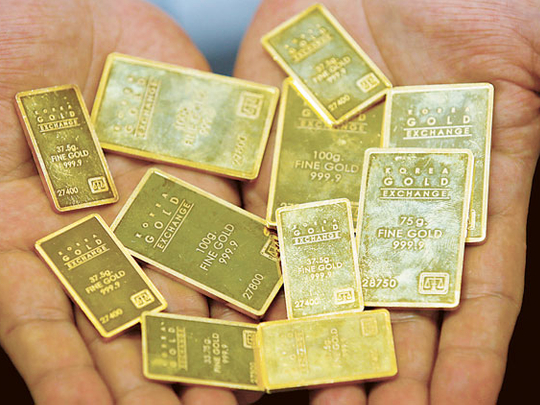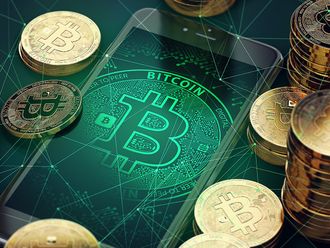
New York: Gold is having a summer revival.
The price of gold touched $1,420 an ounce last week, a three-and-a-half month high, as escalating tensions in the Middle East, volatile currency markets and renewed demand for jewellery in China and India pushed prices higher.
Gold has rebounded 15 per cent to $1,396 an ounce since sinking to $1,212, its lowest level in almost three years, on June 27. A gain of 20 per cent or more would put the metal back in a bull market.
Gold’s resurgence follows a rough ride this year.
Gold slumped 4.8 per cent in the first three months of 2013 as the outlook for the economy improved while inflation remained subdued.
For many years prior to that, large investors, like hedge funds, bought the metal as a way to protect their investments against rising prices and a slumping dollar. They feared that the Federal Reserve’s stimulus program could cause prices to rise. But inflation remained subdued and that reduced the need to buy gold. Also, signs in January that the dollar was strengthening diminished the appeal of owning gold.
Then in April, the bottom fell out. A proposal that Cyprus sell some of its gold reserves to support its banks rattled traders, prompting concern that Spain, Italy and other weak European economies might also sell and flood the market.
Gold plunged by $140 an ounce, or nine per cent, on April 15 as investors unloaded their holdings. That was the biggest one-day decline in more than 30 years.
While the price of gold is still down 17 per cent this year, the metal is on the rise.
Here are the factors driving its comeback:
A little insurance
One of the reasons people buy gold is that it offers an alternative to more traditional financial assets, says Mike McGlone, director of research at ETF Securities, a provider of commodity-based exchange-traded funds. When financial markets get jittery, investors often buy gold because it is considered one of the safest assets that can easily be converted to cash.
As the stock market soared this year, rising as much as 20 per cent, investors had less need to hold gold.
That has changed the last four weeks.
The Standard & Poor’s 500 index has lost 4 per cent since reaching an all-time high of 1,709.67 on August 2. Traders are concerned about when and by how much the Fed will pare back on its stimulus, a major driver behind the market’s rally.
Strife in Egypt and Syria has also reminded investors that it’s a dangerous world out there: wars can spread and oil prices can spike, hurting economies and stock markets.
Investors want to add back a little insurance to their portfolios these days.
“If we lived in a perfect world, we would not need gold,” says McGlone. “But since we don’t, we do need something that is the ultimate store of value.”
Investors don’t need to buy gold bars or coins to invest in the metal.
Exchange-traded funds are investments that are similar to mutual funds. Both can be bought and sold on exchanges. Some of these funds, such as ETF’s Physical Swiss Gold Shares and SPDR’s Gold Shares, allow investors to buy into trusts that invest directly in gold.
Haven from stormy currencies
The Fed appears close to reducing its $85 billion in monthly bond purchases, and that has stirred up currency prices worldwide, particularly in emerging markets. Investors had previously borrowed in dollars at low rates and then invested in faster growing economies in Asia and Latin America.
Now, that trend is reversing. US interest rates have started to climb in anticipation of the Fed’s reduced stimulus. Investors are selling their emerging-market holdings and converting the proceeds back into dollars.
The value of the Indian rupee against the dollar has plunged by more than 11 per cent in August on concerns that surging oil prices are pushing the country toward an economic crisis. The Indonesian rupiah has also slumped.
When currency markets become volatile, investors worldwide look to invest in safe assets that will hold their value, says Dan Heckman, a national investment consultant who specializes in commodities at US Bank Wealth Management.
“Gold does fit that role,” he says.
Jewelry buyers
Speculators like hedge funds were behind the surge in gold over the last decade. That sent gold to a peak of $1,900 an ounce in September 2011. It also priced out a large part of the market - jewellery buyers in countries like India and China. In those countries, people have traditionally bought jewellery as a way to invest in gold.
When prices slumped this spring, though, those buyers jumped back in because people in those countries bought more gold.
The World Gold Council, a trade group for gold mining companies, says in a report on August 15 that consumer demand for gold surged 87 per cent in China in the second quarter, compared with the same period a year earlier. Demand in India climbed by 71 per cent.
Gold still remains far below its inflation-adjusted peak. It rose as high as $873 an ounce on January 21, 1980. Adjusted for price increases that would be worth $2,475 in 2013.












